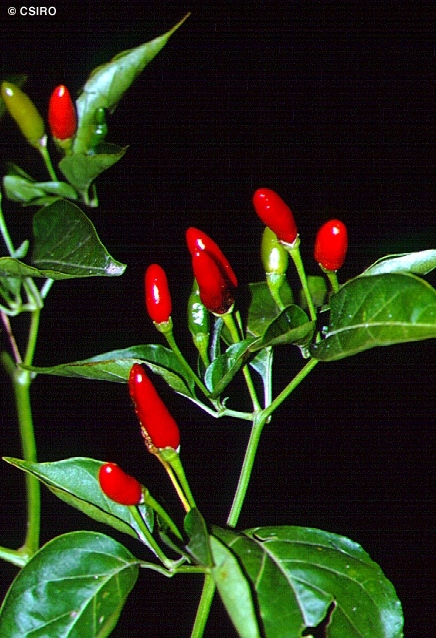Australian Tropical Rainforest Plants - Online edition
Capsicum annuum var. glabriusculum (Dunal) Heiser & Pickersgill





Heiser, C.B. & Pickersgill, B. (1975) Baileya 19 : 156. Type: Mexico, near Bejar, Berland 1863; near Tampicode de Tamaulipis, Berland 95; holo: ?.
Pepper, Bird; Chiltepine; Bird Pepper; Chilipiquin
Usually flowers and fruits as a shrub about 1-2 m tall.
Flowers solitary, rarely two in each axil. Pedicels geniculate until well after anthesis. Calyx about 2-3 mm long, lobes scarcely discernible. Corolla about 10-15 mm diam. Anthers blue, green or purple, about 1.5-2.5 mm long, filaments about 1 mm long. Pollen pale yellow. Ovary glabrous, about 2.5 mm long, style glabrous, 4 mm long. Stigma green.
Fruits burn the mouth and lips if eaten. Burning sensation will occur if the face or eyes are touched after handling the fruits. Fruits about 25 x 5-10 mm, pedicels about 15-35 mm long. Embryo somewhat coiled, the radicle curved and the cotyledons coiled or U-shaped. Cotyledons about as wide as the radicle.
Cotyledons +/- lanceolate, about 10-16 x 4-5 mm. First pair of leaves simple, alternate and +/- cordate. At the tenth leaf stage: leaf blade broadly lanceolate to almost cordate, domatia are tufts of hair. Petiole channelled on the upper surface. Seed germination time 27 to 62 days.
An introduced species originally from tropical America but now naturalised in NT, CYP, NEQ, CEQ and southwards as far as north-eastern New South Wales. Altitudinal range in northern Australia from near sea level to 700 m. Grows as an understory plant in disturbed areas in rain forest, monsoon forest and vine thickets.
This species is widely cultivated in temperate and tropical regions. Purdie et al. (1982).





